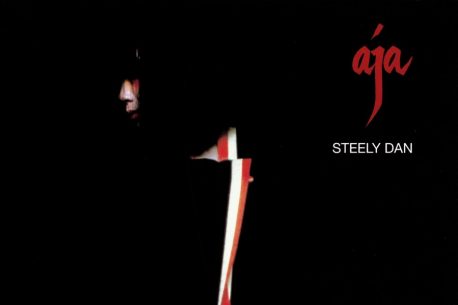
People who followed Steely Dan back in the day must have known before hearing a single note that they were in for a big surprise when Aja first appeared in record stores on Sept. 23, 1977. The first suspicious sign was the album cover: It wasn’t ugly! Hell, its sleek, dark minimalist design on this veneer similar to a freshly wax car was downright vogue and still looks the part today. (Just don’t ask me to interpret it.)
Secondly, when you unfold the cover, there are not one but two sets of liner notes to greet you. Liner notes are quite common on jazz records — at least, they used to be — but pretty rare on rock records. I remember seeing some (rightfully) effusive praise lavished on Boston’s first album that was included with the album, and that was fairly astonishing at the time.
The first essay on Aja, penned by a “Michael Phalen,” was in itself unconventional, taking shots at Walter Becker and Donald Fagen for their less than hospitable treatment of Phalen, Becker’s guitar solo on “I Got the News” and a broadside on their entire back catalog. (The whole Phalen thing is a hoax concocted by Becker and Fagen.)
The second set of liner notes was much more complimentary and composed by the label head himself, Steve Diener. This, too, has irony in that around this time Steely Dan had been complaining to the press about the crappy contract they signed with ABC Records, and were looking forward to getting out from under it and moving forward with Warner Bros. But what is Steely Dan without the irony, right?
The third thing that stuck out pre-needle-to-the vinyl is the personnel, neatly listed for each track. Sure, there were the usual suspects in Victor Feldman, Larry Carlton, Michael McDonald, demoted member Denny Dias and the Chuck Rainey/Bernard Purdie rhythm section. But some other significant names appeared: Steve Gadd, Tom Scott, Lee Ritenour, Joe Sample and Wayne Shorter. Wait, what … Wayne Shorter?!
Taken together, these things signaled a shift in direction for Steely Dan, and is confirmed as the lead-off track “Black Cow” gets underway:
‘BLACK COW’
Steely Dan offers yet another tale of a relationship gone to hell, as the narrator’s disgust at his lover’s “outrageous” behavior continues a larger theme that appeared with increasing regularity on their records: American society is falling farther into an abyss of degenerate and sleazy behavior. Perhaps more specifically, it’s more about what they’ve observed from their Southern California surroundings having now lived there for about five years. But the subject matter was hardly new for them by the time Aja came along.
On the other hand, the music is much more finely tuned on this LP, and that’s where the real story of this classic album lies. Crisp, perfectly modulated, utterly suave and precisely integrated, the sound on this record set new standards. It richly deserved that Grammy for best engineered album, non-classical.
The opening passage of “Black Cow” consists of a two-note guitar punctuation, and a clavinet / bass / drums strut that’s remarkable solely for how well it’s executed. Tom Scott was brought in not just to add a sax solo (he nails it on the coda), but also for soulfully swinging horn arrangements, which matches the prior high-water mark attained on “The Caves of Altamira.”
The all-girl chorus singing brings the sass and Feldman’s Rhodes meanderings deliver understated lushness in the instrumental break. And we’re just getting warmed up. It gets even better on the next track.
‘AJA’
It’s debatable on whether or not this was their plan from the beginning, but by 1976’s The Royal Scam, Steely Dan was clearly aiming to make jazz-rock or jazz-pop that was suitable for mainstream radio. Thus, most of their songs adhered to the 3-5 minute format. The solos can often be interesting, even monumental, but they are rarely extended after 1973’s Countdown to Ecstasy.
Becker and Fagen threw all notions accessibility out the window when they put together what is — to me, anyway — their opus, the sweeping, eight minute semi-suite “Aja.” It consists of three or four unfinished songs pasted together, and with multiple stand-alone sections, that’s just how it sounds.
A song that’s stuffed with so many complexities, there are innumerable discussion points for picking it apart – beginning with that epic Wayne Shorter/Steve Gadd interaction. Another area of intrigue comes from Denny Dias’ guitar solo. (Becker does one too, in between both of Dias’.) In the documentary on the making of Aja, Dias recalls how Becker and Fagan had charted so many notes for his bop-styled solo that it was physically impossible to play them all, so he hit all the most relevant notes that he could. I thought he did a damned good job approximating whatever the composers envisioned.
Perhaps the most remarkable thing about “Aja” is how those three or four fragments are stitched together to make an eccentric harmonic flow, but the stitching is so impressive, one tends not to care. Like Dias, most of the other session players were often befuddled by what Becker and Fagen were trying to get out of them — Larry Carlton served as a de facto translator for these sessions — but for the most knotty of all their arrangements, the results came out without any flaws that any mortal, i.e., anyone aside from the Steely Dan guys, could notice.
Some might dismiss “Aja” as strictly as some snobby high-falutin’ jazz song, but decades years later I can come back to it and pick up some cool little aspect or trick I hadn’t noticed before. That’s the same kind of appeal that had drawn me to jazz. Jazz or not, “Aja” represents the artistic apex of Steely Dan.
‘DEACON BLUES’
This is the song I suppose most people would say has that classic Steely Dan sound, the epitome of the smooth, suave style they perfected on Aja and a hit song to boot at No. 19, with eight weeks in the Top 40 during 1978. A narration in first person about a guy who lives in an alternate reality of a hipster world, but he’s really just a loser. It also had a somewhat bizarre metaphor that is often popularly thought to associate winners with the Alabama Crimson Tide and losers with the Wake Forest Demon Deacons. To be fair, that was an accurate characterization of these college football teams in the ’70s. But the “real” Deacon who Becker and Fagen were thinking of was actually Deacon Jones, a great NFL defensive end from the same era.
Pete Christlieb was plucked from relative obscurity to handle the central sax solo, when Walter Becker and Donald Fagen liked what they heard from Doc Severinsen’s anonymous saxophone player on The Tonight Show and tracked him down. Christlieb pours his soul out on that solo (although he bested himself on “F.M.”), and the crack sidemen on this recording included drummer Bernard Purdie and two of L.A.’s all-time session guitarist champs in Larry Carlton and Lee Ritenour.
For all of those reasons, this a song I should probably like more than I do. Yet, I find “Deacon Blues” a tad plodding. Even if it’s presented as a sarcastic take on the sentimental torch song, it still comes off like a torch song. That’s just a gut feeling about it, but there’s also a part about “Deacon Blues” that is undeniably great, and that’s the nifty little figure used as the intro and again at during the instrumental break. Steely Dan consistently had a way of stringing together chords in a sequence that hadn’t been done before in order to leave a lasting impression, and that highly sophisticated segue is one of their very best examples.
‘PEG’
There might not be a sunnier, snappier tune from Steely Dan than “Peg,” and that’s undoubtably helped to propel the single to No. 11 on the Hot 100 charts. Still, anytime this band sounds buoyant, there’s something skeevy lurking behind the curtain. In this case, the aspiring actress/model that’s the topic of the song is most likely embarking on a career of pornography.
Other Steely Dan hallmarks are also present on this song, like the Michael McDonald backing vocals, a crisp, happy rhythm (this time, by Rick Marotta) and, yes, another iconic guitar solo. There’s that famous story behind this song where Becker and Fagen auditioned six or seven guitarists just for that solo, with each recording their entry over the basic track, and the champ got to spend another six hours perfecting his rough draft.
Jay Graydon was the winner of that sweepstakes, one whose roster of participants was never made public, but it’s a fair guess that it included many the studio guitar all-stars of the time, such as Larry Carlton and Lee Ritenour. Becker and Fagen weren’t looking for the best guitarist, just the best one that day for that song – and there’s a good argument that they did. Graydon’s entry begins, as described by Becker, in a sort of Hawaiian slide before settling into funky single-line note runs that speed up past the beat then slow down behind it. In short, imaginative, precise and unforgettable.
Graydon didn’t parlay his Steely Dan moment into a notable career making fusion guitar records like Carlton or Ritenour did, but he did become a successful producer in the ’80s, working on hit albums by George Benson, Al Jarreau and the Manhattan Transfer, among others. Not much has been heard from him since then, but a legacy long ago established as a composer, arranger, session guitarist, engineer and producer assured him a respectable place in pop music history. And even if it didn’t, the six hours he spent working on that solo for “Peg” is probably enough.
‘HOME AT LAST’
The lyrics for “Home at Last” are inspired by an episode from Homer’s Odyssey where Ulysses attempts to sail home safely after waging battle, but that’s really just a metaphor for Walter Becker and Donald Fagen pining away for their native New York environs from across the country in Southern California. Here again, we’re seeing perhaps Fagen’s old English Lit degree bearing more fruit.
Coming after “Peg” and a couple of songs before “Josie” on Side 2 of the old Aja vinyl, it can be easy to overlook “Home at Last,” but this ranks as one of Steely Dan’s best ballads and best blues. Or at least, blues in the Steely Dan sense of blues, which by this time had become so finely woven into their intricate fabric of melody and harmony, it’s often easy to forget that it’s a blues song.
The Ellingtonian horns add a sophisticated air that smooths over Larry Carlton’s Chicago-tough rhythm guitar, and the whole song is a signature moment for Bernard Purdie’s “Purdie Shuffle,” which reliably installs a strong undercurrent of funk on even this melancholy tune.
This is also the first appearance of Fagen’s trademark blues-y synth solo (more prominent on “Hey Nineteen”) which is countered by Becker’s thoughtful turn on the guitar. Come to think of it, that also marks this the first time that both of the Steely Dan linchpins are the soloists on their own song.
The deep cuts are what separates a classic album from a really good album. Aja is good because of songs like “Peg,” “Josie” and yes, “Deacon Blues.” Tracks like “Home at Last” is part of what makes it an album for the ages. Figuratively speaking or not, remember to leave the needle alone after “Peg” fades out.
‘I GOT THE NEWS’
Shifty, start-stop rhythms, suddenly erupting musical asides and two guitar soloists (Becker and Larry Carlton), “I Got the News” has an irresistible, non-stop energy. The magical part comes on the first bridge, with chorus vocals led by Michael McDonald, quickly followed by a crisp guitar lead that I’m guessing was performed by Carlton. As the only song not discussed on the Aja documentary, this B-side to the “Peg” single is more overlooked than even “Home at Last.” Being the “weakest” track on Aja is no weakness, and “I Got the News” puts to shame so many rock albums’ strongest tracks.
‘JOSIE’
Like “Deacon Blues,” another one of Steely Dan’s Aja hits, “Josie” has a specially written intro revisited later in the song that’s absolutely killer. The song’s subject is the neighborhood party girl who can never say no, and the boys are rejoicing her return.
Take that, along with Chuck Rainey’s brooding bass and Larry Carlton’s and Dean Parks’ richly funky rhythm guitars, and you have one of Steely Dan’s best shindig tunes. This being the ’70s, there was still room on the radio for a blues with half of the expected chords replaced with jazz ones and even become popular: This one reached No. 26 on the Hot 100 charts.
To the already long list of legendary drummers to have played on a Steely Dan date, you can now add Jim Keltner. Ever an equal to Hal Blaine, Jim Gordon and Jeff Porcaro, Keltner has drummed for all the ex-Beatles (except for Paul), Bob Dylan, the Rolling Stones, and Crosby, Stills and Nash. That’s just the tip of the iceberg, too.
His signature fill restarts “Josie” after a brief stop toward the end of the song, a memorable moment and pure Keltner: not flashy, but very, very precise. Another drumming legend would perform on a live recording of this song many years later, but I’m getting a little ahead of myself.
Suffice to say, it’s all world musicianship applied to a tightly constructed song that puts “Josie” over the top and puts an exclamation point to the most solid Steely Dan album of their entire discography.
- Ches Smith Quartet – ‘Clone Row’ (2025) - May 30, 2025
- James Brandon Lewis Quartet – ‘Abstraction Is Deliverance’ (2025) - May 27, 2025
- Soft Machine – ‘Drop’ (1971, 2025 remaster) - May 21, 2025



